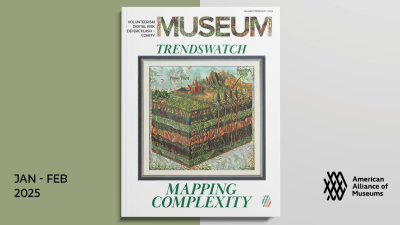CFM Council Member Day Al-Mohamed and I recently led a forecasting session at the Leadership and Excellence in Accessible Design Conference at the Kennedy Center. (An earlier post on the CFM blog solicited your input for this session. Thank you to those who contributed!)
We used a fairly standard format for a mini-tour of the future for any given issue. You can use it at your workplace, too:
- Start by questioning assumptions to free up your thinking about where trends may take us, and how the future could be different than the past.
- Examine and discuss data on trends related to the issue (for this session, we examined trends related to disability and accessibility in the areas of technology, medicine, demographics, and internal museum culture.)
- Generate, discuss and comment on scenarios based on the trends and your own knowledge of the field. (In this post about the MANY conference last spring I described this part of the process in more detail.)
I continue to be haunted by one of the assumptions that Day and I challenged our audience to question: the assumption that when museums balance preservation with access, preservation prevails.
To see how deeply embedded this assumption is in museum culture, consider these examples that I have experienced or heard about in my career:
- An exhibit is lit with annoyingly low light levels even though the artifacts on display are reproductions. Why? Because “that’s our standard” and “if the light levels are higher here, people will expect it everywhere.”
- A museum bans photography on the grounds that flash photography could harm the artifacts when most of the specific artifacts in question are not light sensitive. Nina Simon recently did a good job of questioning this practice on multiple fronts.
- Another good one from Nina: guards who stop people from interacting with exhibits designed to be interactive, because of course, people shouldn’t touch things in a museum. Here’s a recent post by Colleen Dilenschneider with a further twist on this: a guard is fired for interacting with a piece of interactive art.
These examples show how deeply the presumption in favor of preservation is encoded in our current thinking. But what if, in the future, the paradigm flipped to favoring access? Ridiculous, you think? Maybe, but consider factors that could impel such a sea change:
- A shift in consumer expectations. Due to museums increasing commitment to transparency, and the rise in online cataloging, the public is better informed about the vast number of collections in storage that they don’t get to see, and will probably never get to see. Those who pay the bills set the rules—what if they want to touch the stuff?
- An increase in visual and cognitive impairments. The trends data Day and I examined make it clear this will happen—certainly an increase in the number of people with access needs related to disabilities, probably an increase in the proportion of the population as well. Say we got to a point where over 50% of our audience has such impairments. Would that change the way we think about “accommodation?”
- The rise of the virtual, and an increasing desire to interact with the real thing. Every forecasting exercise we have run projects that in the future, people will spend more time spent immersed in virtual worlds. Optimists predict a backlash that benefits museums, as people increasingly value time spent with the real thing. But, as the quality of virtual representations increases, as it will, how will that change our standards for assessing a real experience? How does getting to (virtually) put your nose two inches from a very high-quality visual representation stack up against looking at the real thing, behind glass, from a couple of feet away? How does being able to “touch” an object with virtual sensors compare to being told “don’t touch” the real thing? To compete with increasingly sophisticated virtual replicas, a museum may have to let people have a “real” experience that can’t be duplicated.
- A shift in people’s thinking about a timeframe. Projections of the imminent collapse of human civilization, are not hard to find. Unlike the perpetual recurring doomsday theorists, these folks may have a point. The arc of human growth and resource consumption is, in the long run, unsustainable. And it is far more common for animal populations (human or otherwise) to collapse than to stabilize when they exceed their environment’s carrying capacity. In any case, the question is, what if people come to believe that this is true? That civilization as we know it doesn’t have hundreds of years left, much fewer thousands? In that context, the public might not care so much about the preservation of objects for putative posterity. They might put more value on the immediate gratification of being able to touch, stroke, handle, manipulate original material.
Suspend your disbelief for a few minutes and roll with me on this one. If in the future access trumps preservation, how would museums change? How would you decide which artifacts still warrant preservation for all time, and how do you make that case? Then take a hard look at your existing collections: what things could be touched, or brightly lit, without permanent harm, and which would not be a permanent loss to humanity were they destroyed, through handling, in a few decades of use? Bends your brain, doesn’t it?…
Skip over related stories to continue reading article








In her post, Elizabeth Merritt notes, "Every forecasting exercise we have run projects that in the future, people will spend more time spent immersed in virtual worlds. Optimists predict a backlash that benefits museums, as people increasingly value time spent with the real thing."
To me, this suggests museum folks need to get out more.
Run a forecasting exercise with people who study energy, oil, and resource depletion rates, and you're more likely to get a prediction that 20 to 30 years from now most of us will be busting our tails doing some form of manual labor to make a living in a world in which energy to displace labor has grown fantastically expensive.
I'm not advocating a distopian vision here–I doubt we will see "The Road Warrior" with the setting changed from the Australian outback to Omaha.
Instead, I think our future may look very much like America in the year 1910, with the Internet thrown in. Huge numbers of us will move back into agriculture, the trades, and the mechanical arts. Most commerce will be local and regional. It will be quite different from everything almost every American currently alive has ever known.
And in this different America, having legions of alienated knowledge workers who pine for contact with the so-called "real" is the least of my worries.
So ask me for my projection, and it would go something more like this:
–Art thrives, but art museums enter a challenging period as people have little time and less energy to visit,
–living history museums thrive, largely by becoming vocational classrooms teaching the higher mechanical skills and arts (machine tools, carpentry agriculture)
–there is a great demand for history museums to allow hands-on inspection and operation of mechanical devices of the past–in large part so we can learn how they work and can begin making and using them again. Collections items like my grandmother's hand-crank food grinder are in hot demand.
It's been easy for museums to adopt a one-size fits all model for collections. Everything is precious. There are valid reasons for this, but also some not so good ones. It's one of the ways the museums make them seem important, make people pay attention. It's the moral high ground. And it's the easy way out.
But let's consider an alternative. What if we considered the long-term value of each object separately, and tried to figure out an individual balance of preservation and access. For example: given the opportunity, would we collect it now? If not – maybe that means that it's time to weigh access over preservation, and let the public the most out of the object. Use it up, and give the space in storage to something that fits the museum's collecting plans today. (And we all have up-to-date collecting plans, right?)
–Steve
I'm doing my master's thesis (museum studies) on this very thing: immersive, interactive exhibits, although I am focusing on virtual exhibits, the principles are the same. It seems to be the way of the future!
I apologize for commenting on an old post, but I have been researching ways to measure the effectiveness of 'touch objects' used for education in and outside of museums in relation to the authenticity of these objects.
I understand the thesis promotes access over preservation, but as I am studying the use of object reproductions exclusively what struck me most is that purchasing the most authentic reproductions of museum objects could predict and be of great use for the future in the event of radical environmental changes and further inaccessibility to original artifacts. Could anyone recommend further reading on this part of the blog post or the above comment by eledbetter, who argues for critical examination of past ways of living through living history and object examinations?
Thank you for writing this blog, it has been my most valued subscription!
In reply to J.M. Wasko – some excellent thought on this question by Sharon Leon over at http://blog.preservationleadershipforum.org/2014/08/12/collections-making-room-by-letting-go/#.U_drS7xdVvc